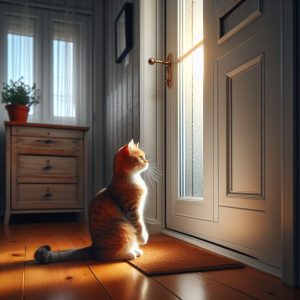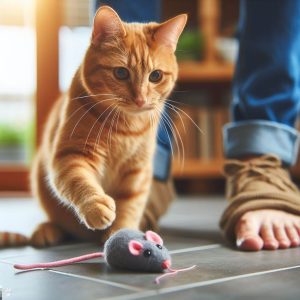Has your furry feline friend started making odd congested, wheezy breathing sounds? Does your cat sound stuffed up, with noisy raspy breathing, coughing, and sneezing? Feline respiratory troubles can arise suddenly, causing distress for both pets and their owners.
Cats can develop congestion and noisy breathing for many reasons. From respiratory infections to heart conditions, several health issues can obstruct a cat’s airways and restrict their breathing. But how can you identify the cause and help your wheezy kitty breathe easy again?
This guide covers all you need to know about congested cat breathing:
Common Causes of Congested Breathing in Cats
Cats can develop congested airways from various health conditions, including:
Upper Respiratory Infections
Upper respiratory infections (URIs) from viruses or bacteria commonly trigger noisy congested breathing in cats. Some examples include:
- Feline calicivirus – Highly contagious virus causing nasal discharge, ulcers, and pneumonia.
- Feline herpesvirus – Extremely common viral infection leading to nasal congestion, eye discharge, fever.
- Bordetella bronchiseptica – Bacterial infection behind kennel cough and sinusitis.
- Chlamydophila felis – Bacterial infection causing conjunctivitis, pneumonia, lethargy.
These URIs are easily passed between cats. They often flare up in multi-cat households or shelters. Vaccination can prevent some but not all respiratory infections in cats.
Allergies
Allergies to pollen, dust mites, mold, or other irritants can trigger upper airway inflammation. Cats with allergies often have itchy eyes, nose, throat, and skin along with nasal congestion.
Asthma
Feline asthma occurs when cats develop hypersensitive airways that constrict and fill with mucus. It leads to wheezing, coughing, and trouble breathing, especially at night or with exercise. Asthma often happens concurrently with allergies.
Heart Disease
Cats with heart disease can cough and wheeze as fluid builds up in their lungs. Other signs of heart problems include lethargy, fainting, and loss of appetite.
Cancerous Tumors
Tumors in the nose, throat, or lungs may obstruct a cat’s airways. These often form from excessive cell growth in older cats.
Foreign Objects
Things like grass seeds, small sticks, or flies can get lodged in a cat’s nostrils or throat, causing noisy congested breathing, gagging, nosebleeds, and discomfort. Kittens are especially prone to sticking foreign items up their noses.
Dental Disease
Bad teeth or dental abscesses in cats release bacteria into their blood. This can cause upper respiratory and lung infections behind noisy breathing. Regular dental cleanings help prevent this.
Rhinitis
Rhinitis refers to inflammation in the nasal cavity lining. Irritants like cigarette smoke, dust, or chemical cleaners can all trigger rhinitis and stuffiness.
Recognizing Symptoms of Congested Breathing in Cats
How can you tell if your cat’s breathing sounds are normal or congested? Be on the lookout for these symptoms:
- Noisy breathing – Whistling, wheezing, snorting, or raspy sounds as your cat inhales/exhales.
- Labored breathing – Exaggerated abdominal movements as your cat struggles for air.
- Open-mouth breathing – Cat breathes with mouth open to maximize air intake.
- Nasal discharge – Watery or thick mucus draining from the nose.
- Sneezing
- Coughing
- Gagging – Often from post-nasal drip.
- Lethargy – Lack of energy or appetite due to congestion.
- Fever – From respiratory infection. Check by feeling ears and paw pads.
- Blue-tinged gums – Indicates oxygen deprivation. Requires emergency vet visit.
Also note if these symptoms worsen at night, with activity, or in certain environments. This helps identify triggers like asthma. Inform your vet about all symptoms you observe.
Dangers of Congested Breathing in Cats
Noisy congested breathing in cats should never be ignored. Upper airway obstructions can quickly become life-threatening for cats.
Cats rely on their noses for around 70% of breathing. Any nasal blockages severely impact their oxygen intake.
Within just days, a stuffy nose can progress to severe pneumonia, collapsed lungs, or heart strain. Lack of oxygen causes damage across the body.
Young kittens, senior cats, and those with existing health issues are most vulnerable. But even healthy adult cats can rapidly decline from respiratory infections or obstructed airways.
So don’t wait “to see if it improves.” Rush your noisy breathing cat to the vet ASAP for assessment and treatment. Timely care greatly improves the prognosis.
Getting Veterinary Help for a Congested Cat
Don’t try to diagnose the cause of your cat’s noisy breathing yourself. Leave it to the professionals! Here’s what to expect at the vet visit:
Physical Exam – The vet will listen to your cat’s breathing with a stethoscope, feel for enlarged lymph nodes, and check their vitals. They’ll assess symptoms and ease of breathing.
Medical History – Inform the vet of your cat’s vaccine/medication status, any prior illnesses, and duration of congested breathing. Mention if it has worsened.
Diagnostic Tests – To pinpoint the cause of congestion, vets may recommend:
- Bloodwork to check for infections and organ issues
- X-rays and CT scans to visualize the chest and sinuses
- Rhinoscopy to examine nasal passages with an endoscope
- Biopsies of abnormal growths to test for cancer
- Fecal exam to check for parasites
- Feline asthma screening
Treatment Plan – Once the vet determines the cause, they will recommend a suitable treatment plan. This may involve:
- Antibiotics for bacterial respiratory infections
- Antiviral medication for feline herpes flare-ups
- Antihistamines or steroids to reduce allergy inflammation
- Bronchodilators and steroids for asthmatic cats
- Surgery to remove tumors or foreign objects
- Oxygen therapy for severe congestion and pneumonia
- Heart medication for cats with concurrent heart disease
The vet may hospitalize very congested cats needing oxygen or intravenous medication. Follow their treatment instructions carefully at home.
Relieving a Cat’s Congestion at Home
While waiting for your vet appointment, use these home remedies to help a congested cat breathe and feel better:
Clear Nasal Passages
Gently wipe your cat’s nose with a warm, damp cloth to remove crusted mucus blocking the nostrils. Ask your vet before using medicated nasal drops.
Offer a Humid Environment
Run a cool mist humidifier near your cat’s bed to loosen mucus and make breathing easier.
Keep Kitty Calm
Help your cat relax and limit activity. Anxiety and exertion worsen breathing issues. Keep handling to a minimum.
Elevate the Food Bowl
Raising your cat’s food and water bowl makes eating and drinking less strenuous with nasal congestion.
Watch for Appetite Changes
Congestion often reduces appetite. Tempt your cat with stinky wet foods or broths. Refrigerating food makes aromas stronger.
Stay Hydrated
Congested cats need increased fluids. Let them drink broth or kitten formula if they refuse water. Use a syringe if needed.
Monitor Breathing Closely
Note any increased respiratory effort, open-mouth breathing, or blue-tinged gums. These require emergency vet treatment.
While waiting for your appointment, focus on keeping your cat as stable and comfortable as possible. But remember – home care is not a substitute for proper veterinary treatment of congested breathing.
When to Rush Your Cat to an Emergency Vet
Get emergency help right away if your congested cat exhibits:
- Severe open-mouth breathing with tongues sticking out
- Pale, blue-tinged gums or tongue
- Little to no interest in food or water
- High fever above 104oF (40oC)
- Collapsing episodes or trouble standing
- Abnormal vocal sounds suggesting airway obstruction
These all indicate a cat is not getting adequate oxygen. Conditions like pneumonia, collapsed lungs, heart failure, or a lodged object require urgent veterinary intervention. Minutes can make a difference, so don’t delay emergency care. It could save your cat’s life.
Ways to Prevent Congested Breathing in Cats
While occasional congestion is hard to avoid completely, you can take proactive steps to minimize respiratory trouble in cats:
- Vaccinate routinely – Core FVRCP shots prevent some URIs. Also consider feline leukemia and chlamydia vaccines.
- Eliminate irritants – Don’t smoke around cats. Limit dust, scented sprays, and other respiratory triggers.
- Reduce stress – Stress and anxiety weaken immunity against respiratory disease.
- Buy dust-free litter – Dusty clay litter can worsen respiratory allergies when kicked up.
- Let cats groom themselves – Bathing removes natural oils that protect against congestion.
- Have yearly vet exams – Wellness checks identify early signs of dental disease, cancer, heart issues and more.
- Get prompt treatment – Don’t wait with respiratory symptoms. Early treatment prevents worsening.
While occasional sneezing is normal, noisy congested breathing, coughing, or gagging signals sickness in cats. Schedule a vet exam for proper diagnosis and treatment. With supportive care, most cats with congestion fully recover and breathe freely again.
The Takeaway: Causes, Symptoms and Solutions for Congested Cats
- Cats can develop noisy, congested breathing from upper respiratory infections, allergies, asthma, heart disease, and other illnesses.
- Signs include wheezing, noisy inhalation, nasal discharge, coughing, sneezing, and open-mouth breathing.
- Congestion can rapidly become life-threatening for cats, so prompt vet care is crucial.
- Vets determine the cause using medical history, exams, x-rays, and other diagnostic tests.
- Treatment depends on the diagnosis but may include antibiotics, steroids, surgery, oxygen therapy and more.
- At home, use humidifiers, elevate food, clear nasal passages, and monitor breathing closely until the vet appointment.
- Prevention centers around routine vet care, vaccines, eliminating irritants, and reducing stress.
Noisy breathing in a cat is always abnormal. By understanding common causes, symptoms, and solutions, cat owners can take prompt steps to help their congested kitty breathe easier again. With proper treatment, cats can make a full recovery and return to their happy, healthy selves.



